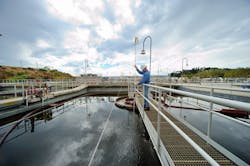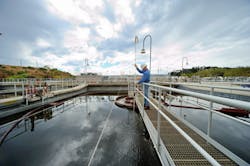2012: A Big Year for Water and a Big Milestone for PPPs
Undoubtedly 2012 has been a year of major anniversaries: The Titanic launched 100 years ago; Queen Elizabeth II celebrated her Diamond Jubilee; and Spider Man turned 50. Less noticeable to the public -- but arguably of far more importance to people's lives -- the Clean Water Act was passed 40 years ago. The CWA has had an enormously positive impact on our environment and improved the quality of life for virtually every person and living thing in America.
Meanwhile, in a small town just outside of San Francisco, another lesser known anniversary is being celebrated: Forty years ago, Burlingame, CA, signed the first public-private partnership (PPP) in the U.S. water industry.
At that time, Burlingame struggled with a range of operational and compliance problems at its wastewater treatment plant. They turned to the private sector for help and, 40 years later, can reflect on considerable success. The operational and compliance problems have long been solved; in fact, the plant has earned multiple awards for operational excellence since then. Power costs have been reduced by approximately $100,000 annually, service levels improved and not a single lost-time accident has occurred in the past 16 years. This list of accomplishments would make any community proud and Veolia Water employees are delighted to be so closely aligned with Burlingame's municipal officials.
When Burlingame made the decision to work with the private sector and establish this first public-private partnership, the community literally pioneered an entirely new model for providing environmental services to U.S. cities. In the years since, that model has adapted and evolved to keep up with the local challenges faced by municipalities throughout North America.
Cities can now choose from a wide range of different packages to help meet their environmental needs. These range from conventional operations and maintenance (O&M) contracts to innovative design-build-operate (DBO) projects to the new Peer Performance Solutions model (PPS), which preserves a public workforce and public governance but infuses private-sector expertise.
Water was a plentiful resource when traditional water and wastewater systems were designed -- and in many parts of the world, it still is. But the reality is that today, our cities must adapt to the challenges of a planet occupied by seven billion people, half of them living in urban environments.
At the same time that we're facing these new challenges, water remains just as critical to the economy as it's ever been. This point was echoed for the first time by the World Economic Forum, which this year ranked water supply crises as an urgent risk. The Water Environment Federation's recent "Water for Jobs" campaign reinforced the point, emphasizing that investment in our water infrastructure is an investment in our future.
The good news is that cities have options. The changing shape of these partnership models, started in Burlingame, provide a window into the type of solutions that cities can utilize to meet these ever-evolving needs.
The examples below represent a different variety of partnership models that Veolia Water has utilized at different times to meet different local needs. Despite their differences, these models represent ways of combining private-sector efficiency with public-sector expertise and illustrate how a model can be taken down very different paths based on the needs of the municipality.
• New Orleans, LA. New Orleans uses the traditional public-private partnership model, and when the partnership was formed in 1992, it represented the largest wastewater public-private-partnership in the U.S. It has delivered many benefits over the past decade, including returning the project to successful operation ahead of all EPA deadlines following Hurricane Katrina. The partnership has generated more than $26 million in overall savings for residents, and has earned multiple awards, including recent recognition for excellence by the United States Conference of Mayors.
• Tampa, FL. Tampa Bay Water uses a model that is still rarely used in the United States but has delivered incredible results -- the design-build-operate (DBO) model, which leveraged expertise in engineering, technology, construction, operations and asset management. By using this model to unify Veolia Water's approach, Tampa Bay Water secured a state-of-the art facility that well exceeds federal and state drinking water standards. Veolia Water delivered substantial cost savings on the project -- saving ratepayers $80 million on what was originally projected to be a $200 million budget.
• New York City, NY. In New York City, the Department of Environmental Protection expects to secure more than $100 million in financial benefits each year through Peer Performance Solutions, a new approach by Veolia Water. The model was built to align with a city's key priorities while both lowering costs and increasing service and performance levels. It does this through a performance-based contract approach, which directly links Veolia's financial compensation with key city goals.
• New London, CT. Since 2008, this town has been operating the nation's most comprehensive water/wastewater public-private partnership. This partnership helps to maintain total asset management and capital program responsibility along with a strong focus on safety and compliance, including ensuring the environmental integrity of the Thames River and Long Island Sound.
• Leominster, MA. Veolia's partnership with Leominster is one of the oldest in the nation. By rehabilitating an aging plant at a significantly low cost, Veolia Water helped this city save $3.5 million -- nearly 45 percent -- compared with original engineering estimates. Most recently, Veolia Water saved Leominster $2 million on the construction of a new 2-MGD Distributing Reservoir Water treatment plant.
Although the past 40 years have brought success, water and wastewater professionals are not without their share of challenges. As readers of WaterWorld know all too well, the U.S. faces a significant crisis in its water infrastructure. Our drinking water and wastewater systems are aging, with some components more than 100 years old. When you consider that our population is growing and changing, and our environment is being impacted, it has never been more critical to take steps to protect our water resources.
But where do we go from here? Perhaps in looking at where we started and how far we've come in the last 40 years, there are some lessons to be learned and best practices that can be gleaned from Burlingame and the passage of the Clean Water Act. Both represented challenges to the existing status quo. Both represented a strong spirit of innovation channeled toward the public good. We should not be afraid to challenge the existing status quo if it means putting the right solution in place.
Indeed 2012 has been a big year for water, representing two major changes in the way we manage our water and wastewater assets in this country. Looking ahead to the future, we can be assured that the foundational changes that began in 1972 will continue to play an important role in how we manage our water resources in the years to come.
About the Author: Laurent Auguste is president and CEO, Veolia Water Americas, leading Veolia Water's municipal and industrial business activities in both North and South America. He is a member of the Executive Committee for Veolia Water. Based in Chicago, Mr. Auguste has been active in the development of the Water Impact Index, Veolia Water's new tool for measuring the impact of human activity on water resources. He advocated that the Great Lakes serve as the first global implementation site of this new tool, along with the first-ever carbon-water study of a major metropolitan water cycle. He's also the founder of www.growingblue.com, a data-driven, online water resource about our global water challenges. Mr. Auguste is an active board member of the U.S. Water Alliance and the Milwaukee Water Council.



